The Library of Spanking Fiction: Wellred Weekly
|
||||||
|
Articles
Items of interest regarding all things spanking
|
||||||
|
|
A Practical Spanking Machine Why build a spanking machine in the first place? Talk to anyone who enjoys spanking, either as a spanker or the spankee, about spanking machines and virtually everyone raises the following objections:
If only the real world were like that! My own reason for wanting to build a spanking machine was that I too once suffered the loss of a partner who had introduced me to the pleasures of spanking. I do not want to dwell on that situation except to say that as many as ten years after that horrible event I once again had the urge to experience spanking. Unfortunately, like many others, I had no access to a partner who could satisfy the urge. Being somewhat mechanically competent, the idea of building a machine to do the job raised its interesting head. However, with the limited tool and workshop facilities available to me I realized that producing a working design wasn't going to be trivial. It was immediately apparent that solving objection number four above wasn't ever going to be possible, irrespective of the budget available to me. Also, in those days, before computers were commonplace in the home, there were some unknowns that were difficult to wrap my head around. For instance how much 'power' and speed does the average hand have – and what level of sensation does it produce? How would you scale the sensation? On a pain scale of 1 to 10 perhaps? How fast would the striking implement need to travel, how far would it have to travel, would the force of acceleration need to cease once the implement made contact? The only practical way to answer these questions would be to create countless iterations and hope that I would get lucky and not injure myself or spend thousands of hours building various prototypes and hope I wouldn't run out of money (or interest) before the project was completed. In the end I think I did what most people do - I shelved the idea. Later, however, with the ability to simulate mechanical objects on a computer and create 3D graphics with animations, I was able to visualize objects and record their dimensions prior to actually making them. In addition, my partner, a professional Dominatrix, realized that such a machine could be useful for her business. Typical scenarios for its use might be when a client wanted some sort of judicial punishment provided by a 'Matron/Wardress' at a penal institution. I am sure you can envisage your own version of such scenarios. Obviously she had no interest in being the machine's subject but being the machine's operator could in fact provide her with real income. Thus she asked me to reconsider my old ideas and attempt to build a useful device. I agreed and we set about writing a specification for what would be the most useful and yet practical machine for her business. It was soon realized that a useful machine would have to accommodate subjects of various sizes and would also have to facilitate putting these subjects in a system of restraints in order to prevent avoidance of the punitive implements, otherwise the fantasy of the scenario would be destroyed. Also, since this was going to require a significant fabrication effort and some real cost we decided that any 'furniture' built to restrain the subject must also be designed to be useful without the actual spanking machine in place. Thus a piece of 'dungeon furniture' could be used for other applications in my partner's business - caning, whipping, medical play etc., which would help defray costs. I decided to incorporate into the design elements that would allow simple modifications to be made so that the machine could be controlled by a computer. In such a scenario a computer program running on a laptop could be pre-set with the number of spanks, speed, duration of punishment, and then once the subject had secured themselves in the machine with all but one restraint, a switch could be triggered which would lock in place the final restraint – say the right wrist – and it would not release till the punishment program had run its course. I did in fact design all these features such that the machine could be built by a reasonably gifted amateur, who is in the sorry position that I once was, of having no partner. I should state for the sake of honesty though that the actual modifications needed to make the machine fully automated have never been carried out. Design: Restraint Subsystem After considerable thought and discussion, as well as the creation of a large number of illustrations, it was decided that a two table restraint subsystem was optimal. Each table would be the size of an average coffee table - four feet and thirty inches wide. A slot 2.5 inches wide would be cut down the center of each table for half of its length to accommodate modular restraints which would slide along a rod mounted near the bottom of the slot and running the length of the slot. A side rail would be mounted on the long edge of each table to facilitate mounting of the spanking mechanism as well as the modular restraints. Holes would be drilled every two inches all the way through the side rails to facilitate bolting of modular accessories to the mounting rail. 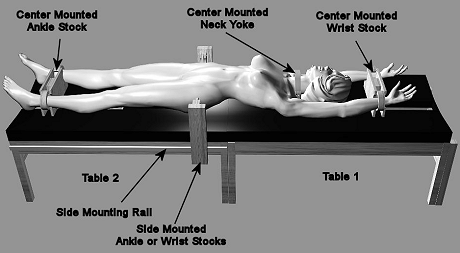 Fig. 1 Fig. 1 shows the subject supine and spreadeagled with appropriate restraints for wrists, ankles and neck. The prone position can also be accommodated with the same restraint setup. Side-mounted restraints can be used in place of center mounted restraints as desired. 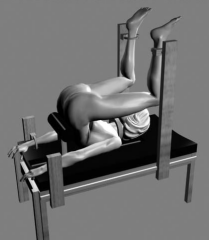 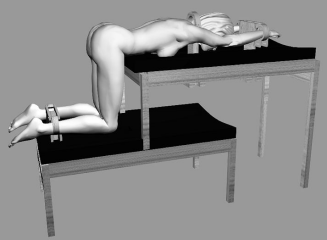 Fig. 2Fig. 3 Fig. 2 shows a single table option for mounting the subject in the lithotomy position with lower limbs elevated, providing good access to the buttocks for spanking or caning etc. This position can be utilized when the spanking machine attachment is added but the original concept for the device was to use a kneeling position as shown in Fig. 3. Here, the legs of the upper table have been lengthened using leg extensions to facilitate the kneeling position. Center-mounted restraints are used to secure the subject. It was soon realized that the kneeling design with the restraints would allow the subject to shift their buttocks back and forth. In order to preclude this a small bar of wood was made to protrude from the upper table which would go between the thighs. Surprisingly this simple modification worked well in practice without the need for a belt to go around the thighs (which would have spoiled the concept of hard restraints). We decided to turn the lower table into a small cage - the final design of the Restraint Subsystem is shown in Fig. 4. Note the side rail mounting system is now shown correctly on the upper table. 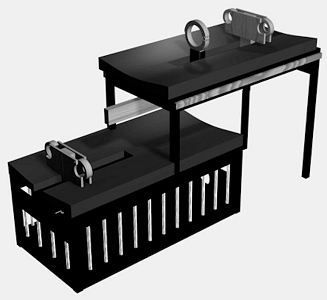 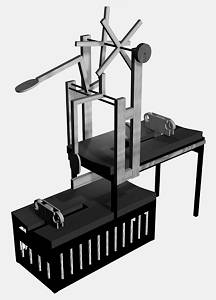 Fig. 4Fig. 5 continued...
|
|||||
| Pages: 1 2 3 4 5 6 7 8 9 10 11 12 13 14 15 16 17 18 | ||||||


